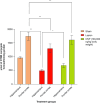Curcumin nanogel and its efficacy against oxidative stress and inflammation in rat models of ischemic stroke
- PMID: 38661738
- PMCID: PMC11221376
- DOI: 10.2217/nnm-2024-0008
Curcumin nanogel and its efficacy against oxidative stress and inflammation in rat models of ischemic stroke
Abstract
Aim: The study was designed to develop and analyze curcumin nanoparticles. Methods: Curcumin nanoparticles were formulated and evaluated. Their efficacy in protecting against brain damage was investigated in a rat model of ischemic stroke, considering motor function, muscle strength and antioxidant enzyme activity. Results: Curcumin nanoparticles displayed a zeta potential of -55 ± 13.5 mV and an average particle size of 51.40 ± 21.70 nm. In ischemic stroke rat models, curcumin nanoparticle treatment significantly improved motor functions, and muscle strength and increased the activities of antioxidant enzymes like glutathione peroxidase, glutathione, glutathione S-transferase, superoxide dismutase and catalase, reducing oxidative stress and inflammation. Conclusion: Curcumin nanoparticles showed significant neuroprotective effects in ischemic stroke models.
Keywords: DLS analysis; curcumin nanoparticles; gelation technique; morphological analysis; neuroprotective effects; oxidative stress.
Plain language summary
[Box: see text].
Conflict of interest statement
The authors have no competing interests or relevant affiliations with any organization or entity with the subject matter or materials discussed in the manuscript. This includes employment, consultancies, honoraria, stock ownership or options, expert testimony, grants or patents received or pending, or royalties.
Figures








Similar articles
-
Curcumin-Loaded Gelatin Nanoparticles Cross the Blood-Brain Barrier to Treat Ischemic Stroke by Attenuating Oxidative Stress and Neuroinflammation.Int J Nanomedicine. 2024 Nov 10;19:11633-11649. doi: 10.2147/IJN.S487628. eCollection 2024. Int J Nanomedicine. 2024. PMID: 39553455 Free PMC article.
-
Effects of curcumin and tannic acid on the aluminum- and lead-induced oxidative neurotoxicity and alterations in NMDA receptors.Toxicol Mech Methods. 2015 Feb;25(2):120-7. doi: 10.3109/15376516.2014.997947. Epub 2015 Feb 24. Toxicol Mech Methods. 2015. PMID: 25496357
-
Facile Synthesis of Curcumin Nanocrystals and Validation of Its Antioxidant Activity Against Circulatory Toxicity in Wistar Rats.J Nanosci Nanotechnol. 2015 Jun;15(6):4119-25. doi: 10.1166/jnn.2015.9600. J Nanosci Nanotechnol. 2015. PMID: 26369020
-
Protective effects of vitamin E and curcumin on L-thyroxine-induced rat testicular oxidative stress.Chem Biol Interact. 2008 Nov 25;176(2-3):121-8. doi: 10.1016/j.cbi.2008.07.009. Epub 2008 Aug 3. Chem Biol Interact. 2008. PMID: 18723006
-
Curcumin protects against cerebral ischemia-reperfusion injury in rats by attenuating oxidative stress and inflammation: A meta-analysis and mechanism exploration.Nutr Res. 2023 May;113:14-28. doi: 10.1016/j.nutres.2023.02.009. Epub 2023 Mar 7. Nutr Res. 2023. PMID: 36996692 Review.
Cited by
-
The role of nanomaterials in revolutionizing ischemic stroke treatment: Current trends and future prospects.iScience. 2024 Nov 15;27(12):111373. doi: 10.1016/j.isci.2024.111373. eCollection 2024 Dec 20. iScience. 2024. PMID: 39669428 Free PMC article. Review.
-
Transforming stroke treatment through nanotherapies.Nanomedicine (Lond). 2025 Apr;20(8):765-768. doi: 10.1080/17435889.2025.2459583. Epub 2025 Jan 28. Nanomedicine (Lond). 2025. PMID: 39875130 No abstract available.
References
-
- Hicks A, Jolkkonen J. Challenges and possibilities of intravascular cell therapy in stroke. Acta. Neurobiol. Exp. (Wars.) 69(1), 1–11 (2009). - PubMed
-
- These J, Taghibiglou C. The overlooked aspect of excitotoxicity: glutamate-independent excitotoxicity in traumatic brain injuries. Eur. J. Neurosci. 49(9), 1157–1170 (2019). - PubMed
-
- Ashafaq M, Alam MI, Khan Aet al. . Nanoparticles of resveratrol attenuates oxidative stress and inflammation after ischemic stroke in rats. Int. Immunopharmacol. 94, 107494 (2021). - PubMed
-
• Explores the effects of resveratrol nanoparticles on oxidative stress and inflammation in a rat model of ischemic stroke, suggesting significant therapeutic benefits in the management of poststroke complications.
Publication types
MeSH terms
Substances
Grants and funding
LinkOut - more resources
Full Text Sources
Other Literature Sources
Medical
